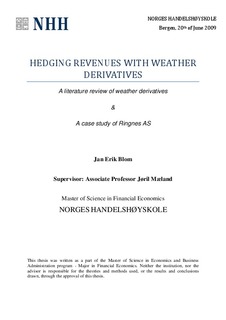| dc.description.abstract | The corporate world has hedged their revenues for decades. By use of futures, forwards,
options and swaps companies have hedged risks related to stock investments,
commodities, interest rates, currency and relevant indexes. A common feature for those
types of risk is that the risks are mainly related to price. Volumetric risk on the other
hand, has largely been left unhedged. A common and important factor to volumetric risk
is the weather. Previously adverse weather has often been used as an excuse for poor
financial performance, and such excuses have to a large extent been accepted by the
market. In the late 90’s a new financial market was developed. A market for weather
derivatives, so that risk managers could hedge their exposure to weather risk. After a
slow start the weather derivatives market have started to grow rapidly. Risk managers
can no longer blame poor financial results on the weather. Weather risk can be removed
by hedging.
This thesis will explain briefly what a derivative is and point out some motives for use
of derivatives. Thereafter we will look at the history of the weather risk market, how the
weather risk market has developed in recent years and also who the current and
potential players in the weather risk market are. The most famous methods for
valuation of weather derivatives will also be introduced and discussed. Finally problems
and possibilities of the weather derivative market will be briefly discussed.
After the general part about weather derivatives a case study will be conducted on the
Norwegian brewery Ringnes AS. First several regressions are run to model the relation
between beverage sales and temperature. Next the chosen model is used to decide the
relation for a given period of time. After the relation between sales and temperatures is
analysed, appropriate hedging strategies are discussed. Some chosen hedging strategies
will be evaluated by use of common weather derivative valuation methods. Finally these
analyses form the foundation for a conclusion whether or not Ringnes AS should
implement weather derivatives in their risk management strategy. | en |
